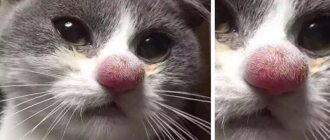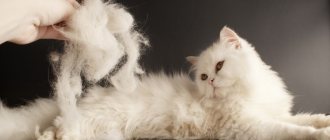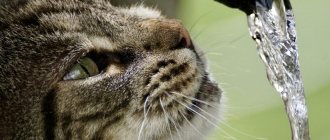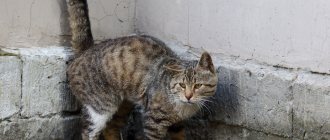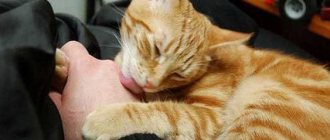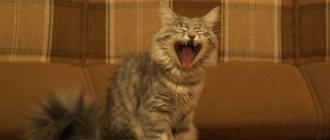If a cat licks its fur right down to its skin, this may be a sign of severe stress and the influence of other external factors. In veterinary medicine, this phenomenon is known as overgrooming.
If owners notice hairless patches on the belly, back, tail, hind legs and other parts of the body, the problem may be lice, fleas or small parasites.
Wounds that a cat scratches to the point of bleeding can lead to serious complications, including sepsis, if owners do not seek treatment for the underlying condition.
What to do if a cat licks its fur?
Cats are very clean, and licking their fur is a normal need. It cleanses the cat's fur of impurities and improves its thermoregulatory properties.
Our furry pets spend a lot of time grooming their fur every day, but if you notice that this grooming process has become obsessive, licking your cat's fur all the way down to the skin, it's important to find the cause.
Frequent intense licking is an alarming signal indicating the presence of any abnormalities or complications.
Causes of Excessive Licking
The cat's tongue has spines that effectively clean the fur and skin. After eating, the cat must lick its face and ears. However, if the cat does not eat, does not sleep, but licks more and more each time, this is a sign that the animal has health problems:
The owner must monitor the behavior and condition of the animal. Excessive licking develops into a habit that persists even after the cause is eliminated. With timely treatment, the habit goes away spontaneously in about 20 days.
Diagnosis of alopecia
If you notice signs of hair loss in your cat, take her to your veterinarian. He will order tests and, based on the results obtained, make a diagnosis and prescribe treatment. The list of measures for diagnosing alopecia includes:
- clinical examination;
- interviewing owners and collecting medical history;
- examination of hair roots under a microscope;
- general blood analysis;
- specific blood tests (for example, hormonal);
- taking scrapings from the affected areas;
- ultrasound or x-ray if a tumor is suspected.
Why is overgrooming dangerous for cats?
Frequent and intense licking of a cat's fur can have serious consequences for its health.
The main signs of excessive grooming are:
- Baldness, hairless areas, bald spots on the body;
- Areas with sparse, brittle hair;
- Deterioration of coat condition;
- allergic symptoms;
- Scratches, ulcers, long-term non-healing wounds on the body;
- Drowsiness, apathy, or, conversely, constant anxiety.
Frequent licking can damage any area of the dermis that the cat can reach with its tongue. Lesions are most often observed on the abdomen, inner surface of the hind legs, front legs, flanks and sternum. The lesions are located symmetrically on the body.
By intensively licking the fur on its hind paw or tail, a cat can injure itself. If an infection gets into the wound, it will lead to acute inflammation in the deeper structures of the dermis. In severe cases, if the cat chews the skin, necrotic lesions may develop at the site of the injury.
Fleas, dewormers, viruses and bacteria can be acquired from fur by licking the skin. Excessive grooming can lead to disruption of the natural process of hair replacement, deterioration of the protective properties of the coat and dermis, which is especially dangerous for cats moving on the streets.
Stress
Unusual or even inappropriate behavior in a cat is not always a consequence of its poor physical health. Sometimes the reason has an emotional basis.
There are many situations that can cause stress in an animal:
- Relocation of a family member;
- Moving furniture;
- Loss of a pet's favorite toy;
- The appearance of another pet in the house and much more.
A cat's life is predictable and orderly, and everything that brings change is not always good for it.
Owners often try to impose their own rules on the cat.
But a freedom-loving cat may have its own ideas. You can't just rush the cat, it won't work. You may cause emotional distress. It is better to find mutual understanding with your pet.
Compromise is the only way out of the situation.
If the animal feels itching, it will actively lick the area. There is a clear pattern: a cat will lick wounds more thoroughly than scratch them. If the licking area is large, it means the cat is itching. In addition, attentive owners have noticed that when cats itch, they often lick their back, belly and other parts of the body.
Parasites can cause increased licking of fur
Both internal and external infections can make your cat want to lick the skin. In cases of parasitic infection, excessive licking is usually localized.
For example, an animal infested with fleas will lick and nibble on areas where there are blood vessels nearby: the belly and tail area. He will also scratch your neck and head in places where his mouth cannot reach.
If your cat is constantly licking under her tail, she may have worms, as their presence causes itching in the area.
Cats suffer from the following types of worms:
Worms attack various organs of the animal, including the liver, brain and lungs. However, regardless of where they live, they use the host's feces to spread.
Feces contain worm eggs, which secrete substances that cause itchy skin. As a result, the animal will actively lick the area under the tail, allowing new individuals to enter the body.
Check your pet's fur for skin parasites. Flea eggs (the insects themselves) or ticks, not yet swollen with blood and not visible in the fur, may be on parts of the body that attract your pet's attention. Look for signs of worms in your cat's feces.
If your cat constantly scratches and licks itself, but there are no fleas, small mites of the genus Sarcoptes scabiei may be the cause of the illness. These parasites can cause sarcoidosis, a disease characterized by red, scaly, and itchy skin. It can also happen that a cat licks its belly to the point of going bald due to demodex.
Demodex cati mites, like in humans, can coexist peacefully with a healthy person, manifesting themselves when the immune system is weakened. Foci of infection are located on the neck, head, ears and eyelids.
The presence of invisible parasites can be detected by a veterinarian by examining scrapings from the affected areas. Treatment depends on the type of infection. To combat skin parasites, a specialist may recommend an external remedy, for example, Bars Forte drops, which fight many arthropods. The drug kills larvae and adults by affecting their basic biological processes.
For diseases caused by helminths, it is convenient to use drugs in the form of dry food. Cats eat them more readily than tablets or emulsion - in this form they will easily spit out the medicine.
All types of medications are prescribed as part of treatment. Repeated use of the drug should be resumed after approximately 10 days. If helminths are detected, it is recommended to carry out preventive treatment of all inhabitants: people and animals.
Skin pathologies (allergies, flea dermatitis, tick-borne infection, etc.)
Flea dermatitis Dermatological problems in cats are usually accompanied by constant itching of the skin. To calm it down, animals lick themselves. Persistent licking often provokes hair loss in the areas being licked. The following skin diseases can lead to this behavior:
- allergies to food, pollen of flowering plants, household chemicals, cosmetics used by the owner, etc.;
- dermatitis caused by fleas;
- infections caused by ectoparasites, such as ticks and lice-eaters;
- diseases caused by fungi.
Worm infestation can also cause compulsive licking. Parasitic diseases are accompanied by itching in the anus. Trying to calm it down, the animal licks this area, as a result of which, over time, bald spots form around the anus. To eliminate this problem, antiparasitic veterinary drugs are used.
To choose a suitable anthelmintic, you need to find out what type of parasites attacked the cat’s body. This can only be done in a veterinary clinic.
Problems not related to diseases
In some cases, excessive licking is not caused by any health problems.
This can be caused by various reasons, the most common of which are
- Stressful situations cause nervous tension, but in this case the cat’s behavior also changes. Her tail quivers, she shakes constantly, and her pupils are greatly dilated. Such conditions can occur during movement, with a sudden change in environment, or with aggressive behavior of other animals or owners.
- The desire to get rid of foreign odors, which most often manifests itself when a cat is stroked by a stranger or after returning from a walk in the fresh air.
- Fear of closed spaces, which may seem strange, but staying indoors for a long time has a negative effect on the cat’s psyche. In this position, he can lick himself to the point where serious wounds occur.
- Active grooming in the tail area when the female is in estrus, which is an attempt to clean the tail.
All pathological conditions should always be under observation, and the animal should not be deprived of attention.
Frequent and prolonged licking quickly leads to habituation, called excessive grooming. This is a mental disorder that is most common among purebred cats, but is also common in regular pets.
A glaring case or a pattern?
Lucky is the owner who has never encountered problems with hair loss in purebred pets, even the owners of Sphynxes are no exception, because they come in velor. Cats of “noble” breeds have stronger immunity, but if maintenance standards are violated or they come into contact with other individuals, they can get sick like everyone else. Next, we’ll look point by point at one of the problems that every fifth cat owner faces.
Important! If you look at the basics, there can be only two reasons - skin problems or a general disease, so hair loss is a symptom, not an independent disease.
How to help a cat
To help your cat, you need to get to the root cause of the behavior problem. If the cause is a disease, the veterinarian will recommend symptomatic treatment with general and local drugs.
It is equally important to eliminate the factors contributing to the problem. Review your cat's diet, create optimal conditions and protect your cat from stress.
After treatment, bring your cat to the clinic several times a year for a comprehensive examination. In case of excessive care due to chronic pathology, relapses may occur.
Vitamin and mineral preparations, dietary supplements and animal shampoos with antiseptic and anti-inflammatory effects help restore the coat.
Examination by a veterinarian and diagnosis
The effectiveness of treatment depends on an accurate diagnosis. As mentioned above, you should definitely contact a special clinic. Prescribing medications yourself is very dangerous. From such “treatment” the cat may lose all its fur.
At the veterinary hospital, your pet will be able to undergo the necessary examinations. One of the main tests is a trichogram. Thanks to it, they receive information about the condition of the coat, making the first conclusions about the causes of the disease.
To care for a cat, you need to know what a furminator is for, whether cats need clothes, everything about mating cats, how to choose a comfortable carrier, whether you need to sterilize a cat, how to trim a cat’s claws, how to make toys for a cat with your own hands, how to give birth to a cat how to make a scratching post.
Did you know? Smuggling cats from ancient Egypt was punishable by death.
Dangerous complications
Excessive grooming is a fairly serious deviation that can lead to negative consequences. Lack of timely and proper care can lead to:
- The formation of wool plugs in the cat's stomach and intestines, which leads to obstruction and accumulation of feces.
- The formation of non-healing wounds, ulcers or scratches, which are open gates for various infections. In severe cases, this can lead to the formation of necrotic lesions. To prevent this, wounds should be treated with antiseptic sprays and ointments and covered with bandages and plasters.
- The natural growth of the coat is disrupted and its protective functions deteriorate.
Excessive grooming is a pathology that requires a special approach and great responsibility. If it is caused by physiological health problems, treatment should be aimed at eliminating them. After recovery from the underlying disease, pathological licking will go away spontaneously.
Psychological problems will require more attention. Don't limit their freedom, play for at least 15-20 minutes a day, pet them regularly and show them love.
When moving, take familiar things with you, such as a cat house, scratching post or bed. In severe cases, veterinarians may prescribe medications to normalize the cat's condition.
